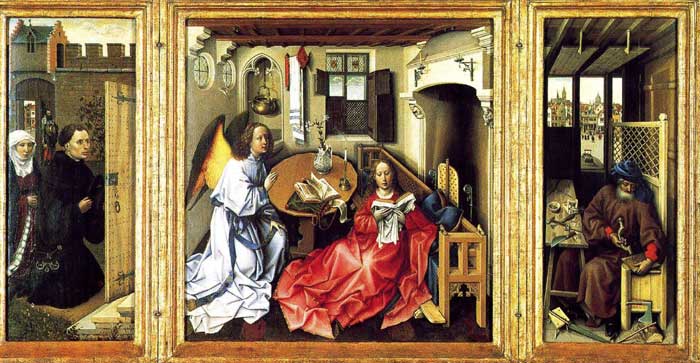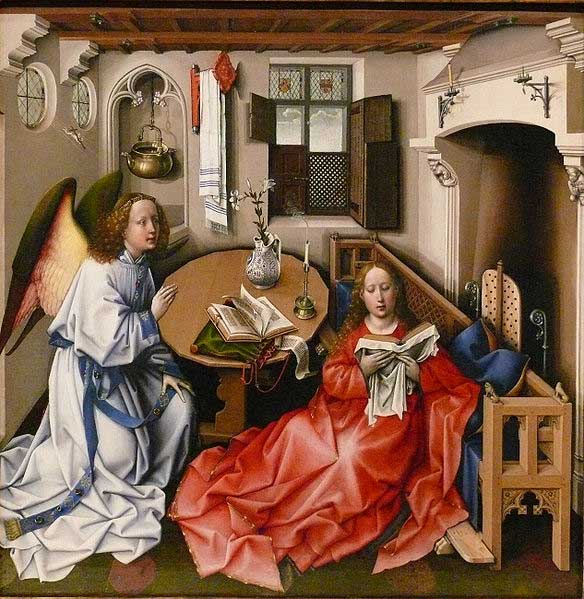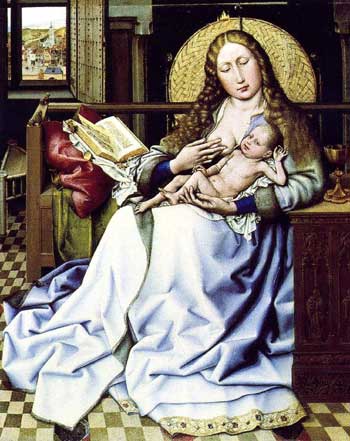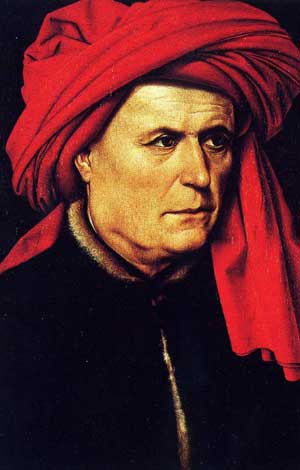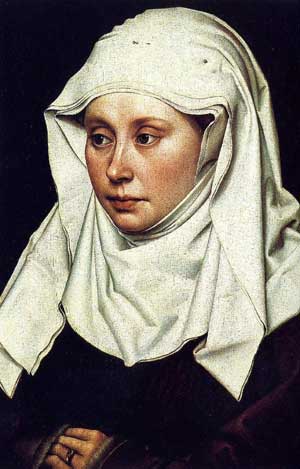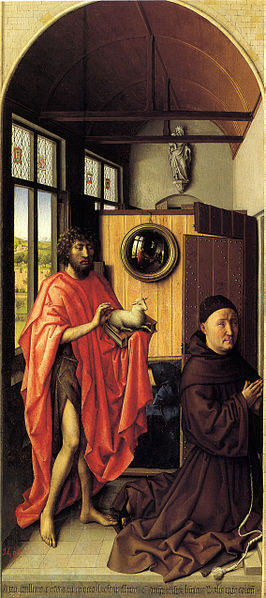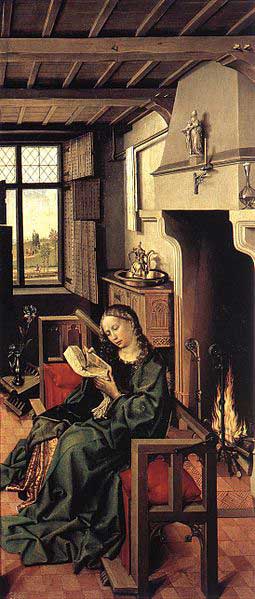The Seilern Triptych
Robert Campin
Robert Campin (ca. 1375/1379-1444), Attributed to, The Seilern Triptych – The Entombment, 1425 (circa), @The Samuel Courtauld Trust, The Courtauld Gallery, London.
The Seilern Triptych is one of the finest masterpieces of Early Netherlandish painting. It was painted by a highly talented artist who has been identified as Robert Campin from Tournai, also known as the Master of Flémalle.
The triptych shows the narrative of Christ’s passion. In the left wing, though Christ’s body has been removed from the central Cross, the thieves remain in torment on their crosses. A donor kneels in the foreground directing his gaze to the central panel, where the body of Christ is lowered into the tomb by Joseph of Arimathaea and Nicodemus. The Virgin, supported by St John, leans over to kiss Christ; the other women are the Three Marys. Four angels carry the Instruments of the Passion: the spear, the Crown of Thorns, the nails and the sponge. In the right wing, the resurrected Christ watched by an angel steps from the tomb, which is guarded by three soldiers.
No documentation survives concerning this work or the commissioner. Apparently too small to have been used as an altarpiece, it may have been displayed in the donor’s home. When open, the triptych was designed to be seen with the wings at a slight angle. Every aspect of the painting has been considered carefully. The gold background is decorated with plants (redcurrants, vines and the gourd) referring to the Mass, the Eucharist and the Resurrection. The colours are carefully balanced, and the striking linear patterns contribute to the powerful decoration and expressive effect of the triptych as a whole.
-------------------------------------------------------------------------------------------------------------------
Robert Campin.
The Master of Flémalle.
Robert Campin is generally accepted (but not universally) as the painter who was previously identified as "The Master of Flémalle." Born c. 1380 Campin is considered to be one of the first artists to depict realistic interpretations of his painted subjects.
Along with his contemporary, Jan van Eyck, he was also among the first to experiment with oil paints.
Campin worked in the town of Tournai, on the southern border of Flanders and became a citizen of that town in 1410. It would appear that he held some civic office in Tournai but lost his post due to a scandal involving adultery and the keeping of a mistress.
These misdemeanours, in addition to his involvement in political disturbances within the city, resulted in Campin being exiled for a year. However, due to the intervention on his behalf of Countess Jacqueline of Hainault, his punishment was reduced to a fine. In 1427 Campin took two apprentices into his workshop: Jacquelot Daret and Rogier van der Weyden (at this time Van der Weyden was known as Rogelet de le Pasture.)
The artistic styles of Robert Campin, Van der Weyden and Jan van Eyck are often intertwined making the attribution of works to these artists difficult.
In particular distinguishing the paintings of Campin and Rogier still manages to create debate among some scholars to this day.
The Mérode Altarpiece. c. 1425-30. Metropolitan Museum of Art. New York. (s)
The Mérode Altarpiece is a triptych whose three panels show, the donor and his wife, left panel, The Annunciation, middle panel, and St Joseph on the right panel. The mysterious figure of the donor in the left wing wears the badge of the town of Malines but his identity is unknown.
The central panel is a depiction of a middle-class room in which the Annunciation takes place. The settee which the Virgin leans against is typical of a style common in the Netherlands but the room is filled with the religious symbolism associated with this event. The lilies in the vase symbolise Mary's virginity. The scroll and the book represent the Old and the New Testaments. The room is lit by rays of sunlight at the top left of the painting, a miniature crucified Christ is carried on one of them and is about to enter the Virgin's body. The light is focused on Mary's dress forming a star shape, a possible foretelling of the star of Bethlehem.
The right panel portrays St Joseph working as a carpenter, he has made a mousetrap evoking an idea by St Augustine that Satan is trapped and defeated in a blood-bated snare within the Passion of Christ.
Mérode Altarpiece. (centre panel )
Robert Campin's portraits of a man and woman are much more realistically defined than his figures in the Salting Madonna and the Merode Altarpiece. They are reminiscent of the work of Jan van Eyck. These portraits highlight the artist's ability to paint the world as he saw it His ability to catch the facial expression of the sitters (probably man and wife) had never before been captured with such delicate character.
Robert Campin's Werl Triptych.
The centre panel of this Triptych has been lost. In the right panel, St Barbara sits reading her book within a middle-class room so typical of Campin. An open fire heats the room from behind the Saint who sits on a bench common in Campin's paintings. St Barbara's green dress is in stark contrast to the red cushions on the bench, above the fireplace, a detailed sculpture of the Trinity can be seen.
The left panel features St John and the donor Heinrich von Werl who is placed prominently in front of St John. In a clear reference to the work of van Eyck, a convex mirror reflects the scene back into the room. Both panels feature windows that show views of the landscape in the distance.
Robert Campin died in Tourni on 26 April 1444.
==================================================
Robert Campin
The Mérode Altarpiece by Robert Campin

I travel a lot around Europe and during my stays in the various towns and cities I always try and spend some time in the local art galleries. The one thing that I do enjoy, which is not often afforded to me in my own country, is the ability to visit local churches in which, especially in France and Italy, one can find beautiful works of art, frescoes and exquisite altarpieces. In this blog I want to look at one of the great altarpieces of the fifteenth century. It was not a huge work of art destined for a church or cathedral but a small devotional work which was to be placed in a room of a wealthy merchant, who had commissioned the altarpiece. The altarpiece I am referring to is an Annunciation triptych known as the Mérode Altarpiece. The work, which was completed sometime between 1425 and 1428, is now part of the Metropolitan Museum collection in New York and the exquisite and beautiful work is attributed to the early Netherlandish painter, Robert Campin and his workshop assistants.
Robert Campin is often referred to the Master of Flémalle. The title “Master of….” was term often used by art historians to attribute an anonymous work or even groups of works. It was a common attribution used in the nineteenth century by German art historians when discussing Early Netherlandish paintings. So how did Campin end up with his title? It is believed that it was due to the fact that three paintings in the Städliches Kunstinstitut in Frankfurt were said to have come from the abbey of Flémalle, a town close to Liège, but have since been attributed to Campin.
Robert Campin was born around 1375 but it is not until thirty years later that his name appears in records. It seems that he settled in Tournai, the Walloon town of Belgium. Tournai is unlikely to have been his birthplace as records show that in 1410 he bought citizenship of the town, which he would not have had to do if it had been his birthplace. Some would have us believe he was born in Valenciennes, now a French town bordering Southern Belgium. This assertion is based upon the fact that the name Campin was very common surname at the time in that town. In the records, Campin’s profession was given as a Master Painter and we know he became a free master of the local Corporation of Goldsmiths and Painters and in 1423 became the sub-dean of the society and later held the post of Eswardeur. During his early years at Tournai, Campin worked for the municipality painting banners and he went on to be employed to paint sculptures in various churches, including the town’s Church of St Brice, and a number of municipal buildings, notably the Halle des Doyens in Tournai . This colouring of sculptures was termed polychromy. He had a good working relationship with the local sculptors including the famous sculptor, Jacques de Braibant.
Robert Campin was good at what he did and soon he and his work became very popular and he received many commissions. His wealth grew and through his commissions and his investments Campin owned a number of properties in Tournai. His standing in the community was high. He was warden of the church of St Pierre as well as procurator of the Convent of the Haute-Vie. All was going so well for Campin. He was running a large successful workshop and had skilled apprentices including a young painter, Rogier de le Pasture who is believed to be Rogier van der Weyden. So life was good until he got involved in local politics and the disturbances in the city between two political factions. Sadly for him he backed the losing side and for his part in the 1429 disturbances and his reluctance to testify against the leaders of the uprising he was sentenced to go on a pilgrimage to Saint-Gilles in Provence. Such a sentence was common in those days as it was thought that during such a pilgrimage one could think about one’s wrong-doings. The local authorities never forgave Campin for his part in the uprising and for a number of years hounded him.
It came to a head three years later, in July 1432. Campin was in trouble again. This time it was because of his adultery. He was married to Ysabiel de Stocquain but at this time was living with another woman, Leurence Polette. The courts took a dim view of this sexual liaison and he was charged with adultery and was once again sentenced to go on a twelve-month pilgrimage. This would have ended his artistic work and the closure of his workshop but this time he was saved from this banishment. His saviour was none other than Margaret of Burgundy, the Countess Dowager of Hinault and the powerful daughter of Philip the Bold and wife of William of Bavaria and his pilgrimage sentence was reduced to a fine. Maybe it was one court appearance too many for after this last incident little was heard of Campin in the archives of Tournai and his lucrative commissions dwindled. Robert Campin died in Tournai in 1444.
And so to the featured work of art by Robert Campin and his workshop assistants, the oil on oak panel entitled The Annunciation Triptych often referred to as The Mérode Altarpiece which was completed around 1432 and is now housed in the Cloisters museum and gardens, a branch of The Metropolitan Museum of Art in New York, which is given over to the art and architecture of medieval Europe that largely date from the twelfth through the fifteenth century. The building and its cloistered gardens are located in Fort Tryon Park in northern Manhattan. Although termed an altarpiece, because of its small size (centre panel is 64cms x 63cms and each wing is just 64cms x 27cms), this was never destined for the altar of a church or cathedral. This was destined for a devotional room in a private house. It is one of Campin’s greatest works. It is thought that originally the painting which comprised of just the central panel was completed around 1430 and then later on the request of the prospective buyer, two hinged wings were added and the work became a devotional triptych. It is also understood that the paintings depicted on the wings were painted by different artists, probably Campin’s assistants at his workshop.

The centre panel is a depiction of the Annunciation, which was a common subject for paintings in the fifteenth century. In this depiction Campin has decided the setting of the scene should be a place of domesticity recognisable to people of his time and not set in some palace-like location. The setting is not, as often depicted, the bed chamber of Mary but a living room. Maybe Campin wanted observers of this altarpiece to empathise with Mary and for that she needed to be looked upon as an ordinary young woman – hence no halo! The room is clean and tidy and in some ways defines Mary as a diligent and house-proud female. Look closely at this panel and the first thing which may strike you as being strange is the depiction of Mary. She is sitting on a cushion on the floor and not on the bench to her left. This could be to illustrate her humility. She is totally absorbed in reading a book but is so careful not to dirty the tome by touching it and so she holds it in a white cloth. She is wearing a long red dress and Campin has cleverly depicted the folds of the dress with the light playing on them so that they form a bright white star. As she sits and reads from her book she seems quite oblivious to the presence of the Angel Gabriel who is to her right dressed in the vestments of a deacon. Between Gabriel and Mary there is a sixteen-sided table which some art historians believe alludes to the sixteen main Hebrew prophets. On the table there is an open book and a scroll, which could have been reference works which were used by Mary as she read her book. The act of reading what was probably a religious work and the presence of a reference book and scroll open on the table portray Mary as a learned and devout woman.
There is a blue patterned majolica pitcher on the table in which there is a lily. The lily represents the purity of Mary. Margaret Freeman, Curator of The Cloisters, comments on the symbolism of the lily quoting St Bernard who wrote:
“…Mary is the violet of humility, the lily of chastity, the rose of charity and the glory and splendour of the heavens…”

We see a highly-polished bronze fifteenth century Flemish candlestick holder with its newly extinguished candle on the table. The flame, which had once been present, represented God and now it is gone, to be replaced by the tiny Christ Child which enters the room on the rays of the sun which beam through the window at the left of the painting. It is a symbol of the Incarnation.

In the left background we see, hanging in an alcove, a highly polished bronze laver. This was the implement originally used by priests when they washed their hands and feet before entering into and coming out of a holy place. Campin’s depiction is of a 15th century Flemish laver. Once again the highly polished laver and candle holder are testament to Mary being a hard working woman who took pride in her house.
The central panel’s Annunciation scene depicts the Angel Gabriel announcing to Mary that she is about to conceive the Christ Child. The Holy Spirit, in the form of the Christ Child, which impregnates Mary, appears descending towards Mary on rays of light emanating from the round window to the left of this centre panel.

When I first looked at this centre panel I completely missed the small figure of the Christ Child with a wooden cross on his back reminding us of the future crucifixion. So why this inclusion? It has been included in this depiction of the Annunciation as what we see before us is also about the Incarnation, the point in time when God becomes man.

There are other little pieces of iconography which are easily missed. Look at the bench seat which Mary rests against. Look at the small carved lions on the top of the arms of the bench. These carvings are known as finials and mark the top or end of some object. Some art historians believe that such an inclusion of the finials refers back to the throne of Solomon. These finials have appeared in many paintings – take a look at the top of the arms of the seat in the background of Van Eyck’s Arnolfini Portrait.

Now look at the left hand panel of this triptych and we see a man and a woman kneeling down in prayer. It is generally agreed that the man is the person who commissioned Campin to produce the work and the lady next to him is his new wife, so new that it is thought she was added later. – but who are they? The answer seems to come from various clues dotted around the triptych. If you look back at the central panel and the transom of the left hand window at the back of the room you will see a coat of arms. This was the coat of arms of the Engelbrecht or Ingelbrecht family of Mechelen who according to records were living in Tournai at the time the altarpiece was being painted and the man was Jan Engelbrecht, a wealthy and prosperous businessman. The painting is thought to have been a wedding gift for his wife and one reason why he commissioned a depiction of the Annunciation could be because of the family name Engelbrecht which translated means “angel brings”. Behind the couple we see a man wearing a straw hat. He is wearing the badge of Mechelen and is believed to be a Mechelen town messenger.

In the right-hand panel, we see Saint Joseph, who we know was a carpenter. Again, like the central panel, there is an air of domesticity about the depiction with Joseph busying himself with his carpentry. He sits at his bench busily drilling holes in a piece of wood. On the table next to him we see all the tools of his trade. Art historians believe each has its own symbolic meaning – the saw refers to the implement that St Peter used to cut off the ear of Malchus, during Christ’s betrayal and arrest; the log alludes to the cross of the crucifixion; the nails, hammers, chisels, pliers and screwdrivers are all likely references to the instruments of the Passion.

Also on the table there is a mousetrap and another on the window ledge, which Joseph has previously made. According the American art historian, Meyer Schapiro, Joseph fashioning mousetraps had a theological meaning and talks about how Saint Augustine used the mousetrap metaphor to explain the redemption of man by Christ’s ultimate sacrifice. He explained the necessity of the Incarnation and that human flesh was the bait for the devil who by seizing it brings about his own ruin. Saint Augustine wrote:
“…The devil exulted when Christ died, but by this very death of Christ the devil is vanquished as if he had swallowed the bait in the mousetrap. He rejoiced in Christ’s death, like a baliff of death. What he rejoiced in was his own undoing. The cross of Lord was the Lord’s mousetrap; the bait by which he was caught was the Lord’s death…”

In my last blog I looked at some works by Joachim Patinir in which he combined biblical scenes with landscapes and townscapes but for Patinir the landscape was the most important part of the depiction. Look now how Campin has in some way combined a small townscape with this religious work. Look at the scene as seen through the window behind Saint Joseph. The window of Joseph’s workshop overlooks a city square around which are various houses, churches and shops. This is not a depiction of a town in the Holy Land at the time of Mary but of a town in 15th century Flanders. It could be that Campin had incorporated a scene from his birthplace, Valenciennes or Tournai or possibly Mechelen, which was the town of the commissioner of this work.
So that is the Annunciation triptych or the Merode Triptych and I suppose the only question you have is why “Mérode Triptych” and not The Engelbrecht Triptych? The answer to that is simple. In the nineteenth century, this altarpiece was owned by Augustine Marie Nicolette, princess van Arenberg, having been given it by her father as a wedding present when she married Charles Antoine Ghislain de Mérode.

